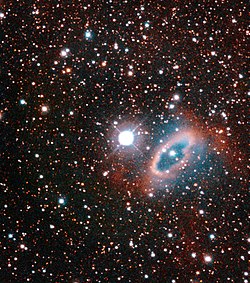| Observation data Epoch J2000 Equinox J2000 | |
|---|---|
| Constellation | Centaurus |
| Right ascension | 13h 55m 52.322s[1] |
| Declination | −59° 22′ 16.45″[1] |
| Apparent magnitude (V) | 7.86[2] |
| Characteristics | |
| Spectral type | B1 Ib[3] |
| Apparent magnitude (U) | 7.34 |
| Apparent magnitude (B) | 8.00 |
| Apparent magnitude (V) | 7.86 |
| Apparent magnitude (R) | 8.88 |
| Apparent magnitude (G) | 7.7591 |
| Apparent magnitude (J) | 7.428 |
| Apparent magnitude (H) | 7.426 |
| Apparent magnitude (K) | 7.385 |
| Astrometry | |
| Proper motion (μ) | RA: −3.376[1] mas/yr Dec.: −1.300[1] mas/yr |
| Parallax (π) | 0.5846 ± 0.0260 mas[1] |
| Distance | 5,600 ± 200 ly (1,710 ± 80 pc) |
| Absolute magnitude (MV) | −5.32[4] |
| Details | |
| Mass | 7.0[5] M☉ |
| Radius | 19.6[6] R☉ |
| Luminosity | 4,124[7] L☉ |
| Surface gravity (log g) | 2.14[7] cgs |
| Temperature | 26,424[8] K |
| Age | 31.6[5] Myr |
| Other designations | |
| Database references | |
| SIMBAD | data |
HD 121228 is a blue supergiant star located in the constellation Centaurus. The star is noted for its close visual proximity to the planetary nebula SuWt 2.[9]
References
[edit]- ^ a b c d e Vallenari, A.; et al. (Gaia collaboration) (2023). "Gaia Data Release 3. Summary of the content and survey properties". Astronomy and Astrophysics. 674: A1. arXiv:2208.00211. Bibcode:2023A&A...674A...1G. doi:10.1051/0004-6361/202243940. S2CID 244398875. Gaia DR3 record for this source at VizieR.
- ^ Zacharias, N.; Finch, C. T.; Girard, T. M.; Henden, A.; Bartlett, J. L.; Monet, D. G.; Zacharias, M. I. (2012). "VizieR Online Data Catalog: UCAC4 Catalogue (Zacharias+, 2012)". VizieR On-line Data Catalog. Bibcode:2012yCat.1322....0Z.
- ^ Houk, Nancy (1975). Michigan catalogue of two-dimensional spectral types for the HD stars. Vol. 1. Ann Arbor, Michigan: Dept. of Astronomy, University of Michigan. Bibcode:1975MSS...C01....0H.
- ^ Melnik, A. M.; Dambis, A. K. (2020). "Distance scale for high-luminosity stars in OB associations and in field with Gaia DR2. Spurious systematic motions". Astrophysics and Space Science. 365 (7): 112. arXiv:2006.14649. Bibcode:2020Ap&SS.365..112M. doi:10.1007/s10509-020-03827-0. S2CID 220128144.
- ^ a b Tetzlaff, N.; Neuhäuser, R.; Hohle, M. M. (2011). "A catalogue of young runaway Hipparcos stars within 3 kpc from the Sun". Monthly Notices of the Royal Astronomical Society. 410 (1): 190. arXiv:1007.4883. Bibcode:2011MNRAS.410..190T. doi:10.1111/j.1365-2966.2010.17434.x. S2CID 118629873.
- ^ Kervella, Pierre; Arenou, Frédéric; Thévenin, Frédéric (2022). "Stellar and substellar companions from Gaia EDR3". Astronomy & Astrophysics. 657: A7. arXiv:2109.10912. Bibcode:2022A&A...657A...7K. doi:10.1051/0004-6361/202142146. eISSN 1432-0746. ISSN 0004-6361.
- ^ a b Fouesneau, M.; Andrae, R.; Dharmawardena, T.; Rybizki, J.; Bailer-Jones, C. A. L.; Demleitner, M. (2022). "Astrophysical parameters from Gaia DR2, 2MASS, and AllWISE". Astronomy and Astrophysics. 662: A125. arXiv:2201.03252. Bibcode:2022A&A...662A.125F. doi:10.1051/0004-6361/202141828. S2CID 245837778.
- ^ Westin, T. N. G. (1985). "The local system of early type stars. Spatial extent and kinematics". Astronomy and Astrophysics Supplement Series. 60: 99. Bibcode:1985A&AS...60...99W.
- ^ "HD 121228". SIMBAD. Centre de données astronomiques de Strasbourg. Retrieved 2023-01-11.
See also
[edit]- Zeta Persei - Same spectral class

Well, that’s interesting to know that Psilotum nudum are known as whisk ferns. Psilotum nudum is the commoner species of the two. While the P. flaccidum is a rare species and is found in the tropical islands. Both the species are usually epiphytic in habit and grow upon tree ferns. These species may also be terrestrial and grow in humus or in the crevices of the rocks.
View the detailed Guide of Psilotum nudum: Detailed Study Of Psilotum Nudum (Whisk Fern), Classification, Anatomy, Reproduction